
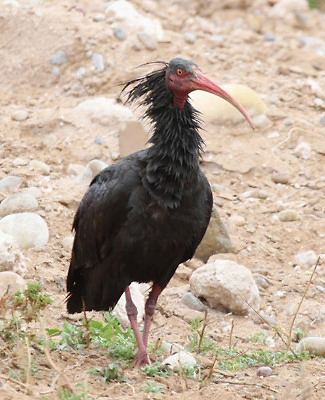
Northern Bald Ibis by Lee Dingain.
- The richest birdlife in North Africa
- All of the North African endemic birds except for Algerian Nuthatch, including Moussier’s Redstart and Desert Sparrow, and many species and subspecies restricted to the Maghreb region of Morocco, Algeria and Tunisia
- As well as Northern Bald Ibis, Greater Flamingo, Cream-coloured Courser, Blue-cheeked Bee-eater, a dozen larks, several wheatears and up to 20 or more warblers
- From the birdy coastal wetlands through the sandy and stony deserts up to forests
and alpine meadows below the snow-capped
Atlas Mountains
- This account deals with the area south to Goulimine (Guelmin)-Asrir and the Tan-Tan Road. South of there is Western Sahara, a part of northwest Africa currently administered by Morocco, where a few birds which are difficult or impossible to see elsewhere in the Western Palearctic occur and a few mammals which are difficult or impossible to see anywhere else in the world can be seen. The main town Dakhla is accessible by air or road (over 1200 km south of Agadir) from Morocco. Birds in the huge Dakhla Bay include West African Crested (Royal) Tern with lots of Caspian Terns. A few Atlantic Humpback Dolphins survive in this bay and are seen occasionally, usually at the northern end. Inland, alongside the Dakhla-Aousserd Road it is possible to see Golden Nightjar (Oued Jenna) and Cricket Longtail (Oued Jenna), as well as Crowned and Spotted Sandgrouse (both drinking at dawn at Gleb Jdiane), Dunn's Lark, Black-crowned Sparrow-lark, Fulvous Babbler, African Desert Warbler and Desert Sparrow, and possibly Pharoah Eagle-owl and Sudan Golden Sparrow (especially at Oued Jenna). The numbers of birds in the often windy desert seems to depend on winter rainfall, with the highest numbers usually after plenty of rain. Mammals present alongside the same road include African Wild and Sand Cats, Golden Jackal, Fennec and Ruppell's Foxes, (Saharan) Striped Polecat, Desert Hedgehog, Lesser Egyptian Jerboa, Fat-tailed and Lesser Egyptian Gerbils, and African Savanna Hare, all of which are most likely to be seen while spotlighting at night. The best time to visit is March to September.
Best Birds and other wildlife in Southern Morocco
Birds
Specialities
Barbary Partridge, Northern Bald Ibis, Cream-coloured Courser, Maghreb (Tawny) Owl, Blue-cheeked Bee-eater, Maghreb (Levaillant’s) Green Woodpecker,
Black-crowned Tchagra, Greater Hoopoe-lark, Bar-tailed, Desert, Temminck’s and Thick-billed Larks, Brown-throated Martin, Atlas (Pied) Flycatcher,
Moussier’s Redstart, Black-throated (Northern/Seebohm's) Wheatear, Streaked Scrub-warbler, African Desert, Isabelline (Western Olivaceous) and Tristram’s
Warblers, Fulvous Babbler, Maghreb Magpie, Spotless Starling, African Crimson-winged Finch and Desert Sparrow. Also a chance of Houbara Bustard (upward of
2000 were being released into the wild each year around 2020, mainly around Merzouga, as ‘game’ for falconers from Saudi Arabia), Crowned, Pin-tailed and
Spotted Sandgrouse, Pharoah Eagle-owl, and Egyptian and Red-necked Nightjars.
There are also distinctive forms of Great Cormorant (maroccanus), Long-legged Buzzard (cirtensis), Crested (macrorhyncha) and Shore (atlas) Larks, White Wagtail (subpersonata), Mourning (halophila) Wheatear, Blue Tit (ultramarinus) and Chaffinch (africana).
Small Buttonquail also occurs in Morocco and Birdfinders run a short tour in early June to look for it, as well as Atlas Flycatcher, near Essouira.
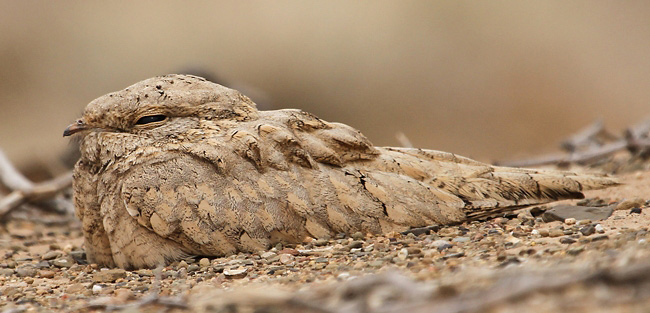
A roosting Egyptian Nightjar in Morocco by Chris Townend.
Others
Ruddy Shelduck, Ferruginous Duck, Greater Flamingo, Balearic and Cory’s Shearwaters, Glossy Ibis, Eurasian Spoonbill, White Stork, Osprey,
Black-shouldered Kite, Bonelli’s and Booted Eagles, Barbary and Lanner Falcons, Black-winged Stilt, Audouin’s and Slender-billed Gulls, Caspian and
West African Crested (Royal) Terns, Black-bellied Sandgrouse, Laughing Dove, Little Owl, Little and Pallid Swifts, (European) Bee-eater, (Eurasian) Hoopoe,
Great (Desert/Southern) Grey Shrike, Alpine and Red-billed Choughs, Brown-necked Raven, Greater Short-toed, Lesser Short-toed and Thekla Larks,
(White-throated) Dipper, Common Bulbul, Firecrest, Zitting Cisticola, Western Bonelli’s, Sardinian, Spectacled and Western Subalpine Warblers, Black,
Western Black-eared, Desert, Red-rumped and White-crowned Black Wheatears, (Common) Nightingale, Blue Rock-thrush, Alpine Accentor, House and Rock
Buntings, Trumpeter Finch, and Rock and Spanish Sparrows. Also a chance of Golden and Short-toed Eagles, European Roller (late spring migrant/summer
visitor), Eurasian Golden Oriole (late spring migrant/summer visitor), Western Orphean Warbler and Rufous Bush Chat (late spring migrant/summer
visitor).
Mammals
Barbary Ground Squirrel. Cuvier's Gazelle has been reintroduced and a few can sometimes be seen above the village of Tafinegoult about 150 km east of
Agadir, east of the Marrakech Road (R203).
Plants
The best times to see the greatest variety of flowers are usually the second half of March and the second half of
May (spring in the High Atlas). Superb heathlands on the Rif Mountains of the far north, which are usually at their best in late March-early April, and
a great diversity of bulbs, also in the far north, which are usually at their best during late October-early November.
Other Natural Wonders in Southern Morocco
Dades and Todra Gorges
These deep, narrow gorges in the High Atlas of central Morocco north of Boumalne have, in places,
almost vertical walls, up to about 300 m (1000 ft) high in the Todra Gorge where, in places, the walls are just about 9 m (30 ft) apart.
Sahara Desert
The Sahara is the largest desert in the world, covering about a third of Africa, but it is only about a
quarter sand. It has vast, shallow troughs made of sand (ergs) but it is largely made up of gravelly plains (regs), rocky plateaus (hamadas) and
isolated mountains. It is the ergs which have some of the highest dunes in the world, some reputedly over 305 m (1000 ft) high. Although those in
Morocco are much smaller they are nevertheless impressive, notably at Erg Chebbi near Merzouga.
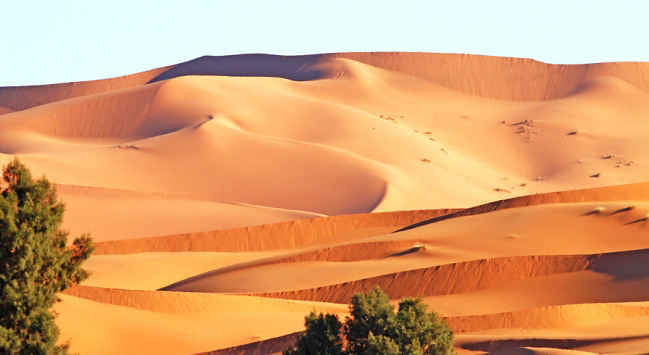
Erg Chebbi near Merzouga, Morocco at the edge of the Sahara by Chris Townend.
Best Sites for Birds and other wildlife in Southern Morocco
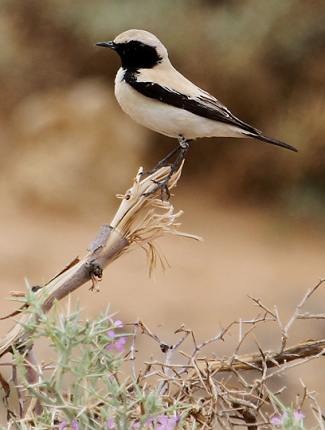
Desert Wheatear by Chris Townend.
- Oued Souss Greater Flamingo, shorebirds, Audouin’s and Slender-billed Gulls, Caspian Tern and Black-crowned Tchagra.
- Oued Massa Barbary Partridge, waterbirds including Ferruginous Duck, Laughing Dove, Black-crowned Tchagra, Brown-throated Martin, Moussier’s Redstart and Barbary Ground Squirrel. Also a chance of Red-necked Nightjar.
- Tamri Northern Bald Ibis.
- Goulimine (Guelmin)-Asrir Spectacled Warbler, Streaked Scrub-warbler, Desert, Red-rumped and White-crowned Black Wheatears, and Fulvous Babbler. Also a chance of Bar-tailed and Thick-billed Larks.
- Tan-Tan Road Greater Hoopoe-lark. Also a chance of Cream-coloured Courser, Lesser Short-toed and Temminck’s Larks, and Trumpeter Finch.
- Oukaimeden Maghreb Green Woodpecker, Alpine and Red-billed Choughs, Shore Lark, Black and Black-throated Wheatears, Moussier’s Redstart, Alpine Accentor, African Crimson-winged Finch and Rock Sparrow.
- Draa Valley Oases A chance of Blue-cheeked Bee-eater.
- Tizi n Timfift Pass A chance of Black Wheatear and Blue Rock-thrush.
- Ouarzazate Blue-cheeked Bee-eater (Mansour Edhabbi), Desert Lark, Desert and Mourning Wheatears, and Fulvous Babbler (Mansour Edhabbi).
- Tagdilt Track, Boumalne Cream-coloured Courser, Black-bellied Sandgrouse, Greater Hoopoe-lark, Bar-tailed, Lesser Short-toed, Temminck’s and Thick-billed Larks, Desert and Red-rumped Wheatears, and Trumpeter Finch. Also a chance of Crowned and Pin-tailed Sandgrouse.
- Todra Gorge A chance of Bonelli’s Eagle.
- Rissani Fulvous Babbler. Also a chance of Pharoah Eagle-owl.
- Merzouga Brown-necked Raven, larks, African Desert and Tristram’s Warblers, wheatears and Desert Sparrow. Also a chance of Houbara Bustard, Spotted Sandgrouse, Egyptian Nightjar, Blue-cheeked Bee-eater, passage migrants and, if the ephemeral lake Dayet Srij has water in it (most likely Nov-May), Greater Flamingo, ducks and shorebirds.
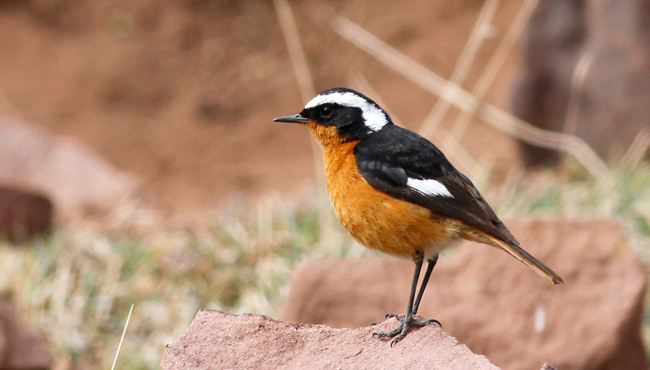
Male Moussier's Redstart by Chris Townend.
Best Times for Birds and other wildlife in Southern Morocco
January-February, mid-March to early May when northbound migrants are passing through, and September to early November.
Recommended Bird Books etc. for Southern Morocco
Collins Bird Guide by L Svensson et al. Collins, 2010 (Second Edition).
Birds of Europe by L Jonsson. Helm, 1999.
Finding Birds in Morocco: Coast and Mountains by D Gosney. Easybirder, 2011 (book and/or DVD).
Finding Birds in Morocco: the deserts by D Gosney. Easybirder, 2009 (book and/or DVD).
A Birdwatchers’ Guide to Morocco by P and F Bergier. Prion, 2003 (Second Edition).
Collins Butterfly Guide by T Tolman and R Lewington. Collins, 2009 (Third Edition).
Mammals of Europe, North Africa and the Middle East by S Aulagnier et al. Helm, 2009.
Apps etc.
Collins Bird Guide.
Where to watch birds in Africa by N Wheatley. Helm, 1995.
Don’t know which country/countries to visit in Africa? Then it may be worth considering taking a look at this book, written by this website’s author. It is many years old of course but it still provides a starting point, an overview and a guiding light to the best birds and the best places to look for them on the continent, and could save hours of searching for similar information on the internet. However, it is important to check more up-to-date sources for sites which have been opened up, sites and species which have been discovered, lodges that have been built etc. since the book was published.
Birding and Wildlife Trip Reports for Southern Morocco
Many trip reports, some for Southern Morocco, are posted on the websites listed here. On some of these websites some reports are independent and some are posted by tour companies who organize tours to Southern Morocco. These tour companies and others also post their own reports on their websites, which are listed under 'Some Organized Tours to Southern Morocco' below.
- The best website for trip reports is CloudBirders
- but these are also worth a look
- Birdtours
- Fatbirder
- Jon Hornbuckle
- Mammal Watching
Local bird and wildlife guides in Southern Morocco
The costs of organized tours partly reflect the quality of the tour leaders. Some leaders are certainly better than others and many companies claim their leaders are the best but even the best rely at least to some extent on the exceptional skills of the local guides they employ. If you are travelling independently, employing such local guides will greatly increase your chances of seeing the wildlife you wish to see.
Accommodation for birders in Southern Morocco
Some Organized Tours for birds and other wildlife to Southern Morocco
There are many tour companies who organize tours to see mammals, birds, other wildlife and other natural wonders. The cost of these tours vary considerably according to such variables as the airlines used, the number of days the tours last, the number of sites visited, the number of people in the group (an important consideration if you wish to see such wildlife as rainforest mammals and birds), the number of tour leaders, the standard of accommodation and transport, and the percentage profit the company hopes to make. Generally, where the number of days tours last and the number of sites visited are similar, the cheapest tours are those that use the cheapest airlines, accommodation and local transport, that have the largest groups with the least number of leaders, and that make the least amount of profit. The most expensive tours tend to be those which are exceptionally long, use the most expensive accommodation (ridiculously lavish in some cases, even for single nights) and which make the most profit. Some tour costs partly reflect the quality of the tour leaders. Some leaders are certainly better than others and many companies claim their leaders are the best but even the best rely at least to some extent on the exceptional skills of the local guides they employ.
While tour companies organize tours with set itineraries many also organize custom tours for individuals and private groups who instead of taking a tour with a set itinerary want to follow their own itinerary to suit their own personal tastes, whether it be mammals, birds, other wildlife, other natural wonders or even man-made attractions, or a mixture of them all. Many organized tours with set itineraries are also fast-paced and target as many species as possible, whether they are mammals, birds or other wildlife or everything, which usually leaves little time to enjoy the best sites and individual species, but on a custom tour those taking part can specify the pace and the sites and species they wish to concentrate on. Custom tours also suit people who like to travel with people they already know, rather than with a group of strangers, and they are popular with people with partners with different interests. Individuals, partners and small groups will almost certainly have to pay more for a custom tour than an organized tour with a set itinerary but a large group of friends may be able to travel for less than the price quoted for a set tour.
Tour companies who run organized tours to Southern Morocco include the following. Many of these also offer custom tours.
- Birdfinders
- Birdquest
- Field Guides
- Sunbird
- Wildlife Travel
- Wise Birding Holidays
- We are a small wildlife watching holiday company based in Devon (UK) specialising in birdwatching and mammal watching holidays across the world. What sets us apart from other wildlife watching companies is quite simple:
- 1 – small group sizes: (average between 4 – 8 people)
- 2 – a commitment to conservation: (donation after each tour)


